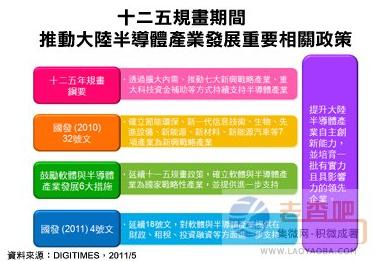 During the period of the 15th Five-Year Plan and the 11th Five-Year Plan period from 2001 to 2010, the semiconductor industry was listed as one of the key support industries by the mainland. Driven by the document No. 18 of the State Development (2000) Document, major mainland wafer manufacturers including SMIC, HEJIAN, TSMC Minjiang, and GRACE During the 15th Five-Year Plan period, successive establishments were made and the production capacity was quickly expanded. The output value of the mainland's foundry industry grew from RMB 3.6 billion in 2001 to RMB 22.1 billion in 2010, and the compound annual growth rate reached 21%.
During the period of the 15th Five-Year Plan and the 11th Five-Year Plan period from 2001 to 2010, the semiconductor industry was listed as one of the key support industries by the mainland. Driven by the document No. 18 of the State Development (2000) Document, major mainland wafer manufacturers including SMIC, HEJIAN, TSMC Minjiang, and GRACE During the 15th Five-Year Plan period, successive establishments were made and the production capacity was quickly expanded. The output value of the mainland's foundry industry grew from RMB 3.6 billion in 2001 to RMB 22.1 billion in 2010, and the compound annual growth rate reached 21%. The performance of the mainland IC design industry also made no effort. Under the encouragement of the No. 18 Document of the State Development (2000), the number of manufacturers doubled from 200 in 2001 to 472 in 2009. The output value also grew from RMB 1.5 billion in 2001 to 2010. With an annual turnover of 38.3 billion yuan, the compound annual growth rate is as high as 43%.
During the period from the 15th Five-Year Plan to the 11th Five-Year Plan period, although the output value of the mainland semiconductor industry has risen sharply, the overall competitiveness is not strong. Take the foundry industry as an example, only SMIC has 12-inch fab capacity, while the remaining foundries only use 8-inch wafer fabs and 6-inch fabs as the main production capacity.
In process technology, only SMIC has entered the nanometer process threshold, while the rest of the manufacturers stay at the micron process technology level. Compared with SMIC and UMC, SMIC also has 2 Yearly technical gap.
During the period of the 12th Five-Year Plan period from 2011 to 2015, the development direction of the mainland semiconductor industry policy will shift from the pursuit of growth in production capacity and output value to the improvement of advanced technology and advanced capacity research and development capabilities; in the past, direct attention from government funds will be used to strengthen the financial market. The operation of the mechanism has nurtured a number of semiconductor companies with technological innovation capabilities and considerable global market share.
Therefore, during the analysis of the 12th five-year plan to support the development of the mainland semiconductor industry, the twelfth five-year blueprint for the national economy and social development program is to expand the domestic demand, promote the seven major emerging industries, major science and technology special fund subsidies, and deepen Financial market reforms and other forms continue to support the semiconductor industry.
Guofa (2010) Document No. 32 establishes that the semiconductor industry is a part of the infrastructure construction under the new generation of information technology. As long as qualified semiconductor companies meet the requirements, they can all obtain policy support. The State Council encourages the six major measures for the development of software and semiconductor industries to continue the 11th five-year planning policy, establish the software and semiconductor industry as a national strategic industry, and provide further support.
As for the document issued by Guofa (2011) No. 4, it is a continuation of Guofa (2000) No. 18 document that specifies the mainland government’s fiscal policy, taxation, investment financing, R&D, talent, and wisdom for semiconductor companies during the Twelfth Five-Year Plans period. Financial rights and other aspects to further support.
Electronic Wire Harness Co., Ltd. , http://www.nsusbcables.com